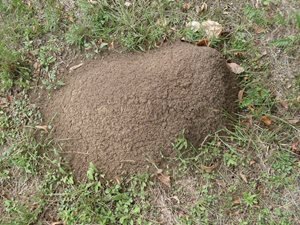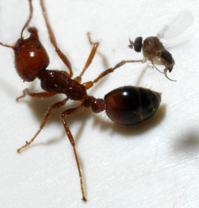Fire ants. Even the name sounds scary. That's because they've got some of the worst attacks in the ant world, both stinging and biting their victims. And tree trimming and vegetation management professionals are likely to encounter fire ants, so it's helpful to know how to identify them and avoid them.

Fire ants can be found throughout Alabama, Arkansas, California, Florida, Georgia, Louisiana, Missouri, Mississippi, New Mexico, North Carolina, Oklahoma, Puerto Rico, South Carolina, Tennessee, Texas, and Virginia. Basically, if you're in the southern United States, you're in fire ant territory.
The easiest way to spot fire ant activity is the fire ant mounds. They can be up to 18 inches tall and 30 inches wide, they lack any kind of center entrance hole in the center, and the dirt is often fluffy. Instead, the ants access the colony from ground level entrances up to three feet away from the mound — right about where you're standing to get a better look at it.
If you spot a fire ant mound in an area where you're going to spend a lot of time, flag the mound and let your other crew members know about it. If you find fire ants on you, brush them off. Don't slap at them. If you have several ants on you, quickly move several feet away from where you were standing, brush them off, and remove clothing if necessary.

Fire ants are also reddish in color but have a brown or black abdomen. They also have a stinger on the abdomen. Fire ants will both bite and sting their victims. They'll clamp on with their jaws so they can sting repeatedly. (Unlike a bee, an ant can sting multiple times.)
A fire ant sting is usually not dangerous; the sting will often form a pustule that will hurt and itch like mad for a few days. You can relieve some of the pain by applying an ice pack, taking an antihistamine, and using a hydrocortisone cream or other anti-itch cream. However, some people can have a severe allergic reaction, get hives, abdominal cramping, trouble breathing, and swelling of the throat. If you have an Epi-Pen, use it, then call 911. See a doctor even if the Epi-Pen works.
If you want to
learn more about fire ants, Texas A&M University has very thorough information for you to read. Or check out Extension.org's article on
Identifying Fire Ants.
Photo credit: Fire ant mound. Robert H. Nunnally, Jr. (Gurdonark) Flickr. Creative Commons attribution license). Fire ant and phorid fly. Sanford Porter (via FreeStockPhotos.biz, Public Domain attribution license).